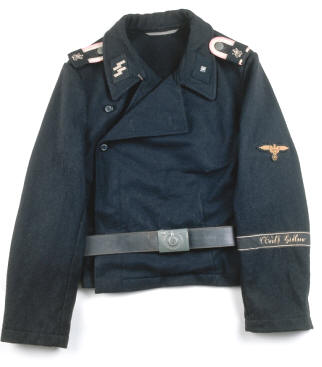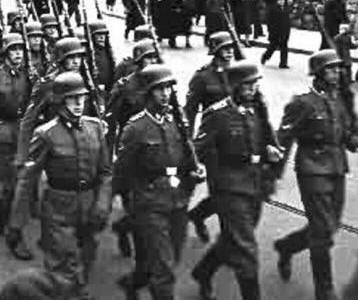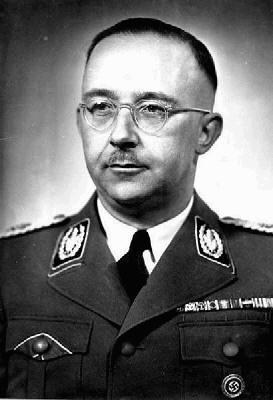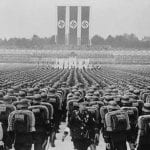The SchutzStaffel or SS was formed in April 1925 as a section of the SA and functioned as a personal bodyguard for the NSDAP leader, Adolf Hitler.
The SS was considered to be an elite force and membership was restricted to those who were pure Aryan Germans.
On 6th January 1929 Heinrich Himmler was appointed leader of the SchutzStaffel. Himmler was an ambitious man and set about building up membership of the SS.

From 1932 the SS wore black shirts with the runic symbol SS on the collar to distinguish them from the SA who wore brown shirts.
Under Himmler’s leadership the SS was divided into three sections:
The Security Section
The SD (Sicherheitsdienst)
Formed in 1931, this section of the SchutzStaffel was placed under the control of Himmler’s right-hand man, Reinhard Heydrich. In its early years the SD was responsible for the security of the Nazi Party. After Hitler became Chancellor in January 1933, the SD was also responsible for seeking out and dealing with those who opposed and were a threat to the leading members of the Nazi Party. The SD played a key role in discovering evidence against Ernst Rohm that ultimately lead to the Night of the Long Knives in 1934.
The Gestapo (Geheime Staatspolizei)
When Hitler became Chancellor of Germany in 1933, Hermann Goering became Minister of the Interior for Prussia. This role gave Goering control of the Prussian Police force. Almost immediately he set about separating the various branches of the Police force. The political and intelligence sections were filled with Nazi Party members and merged to form a secret police force known as Geheime Staatspolizei, the Gestapo.
In April 1934 Heinrich Himmler took over as Head of the Gestapo. Under Himmler’s leadership the Gestapo was responsible for seeking out and eliminating opposition to the Nazi Party. They frequently used torture to extract confessions.
In 1935 the Gestapo was given the task of establishing concentration camps for the incarceration of ‘undesirables’, Jews, gypsies, homosexuals, Communists, unemployed, disabled etc.
After the outbreak of war in 1939 members of the Gestapo made up some of the membership of the Einsatzgruppen, mobile death squads that followed the army into Poland and Russia to rid those countries of Jews and other ‘inferior’ people.
The Military Section – Waffen SchutzStaffel
Leibstandarte SchutzStaffel

After Hitler became Chancellor of Germany he ordered the creation of an armed force which would protect both himself and leading members of the Nazi Party from attack.
The first recruits, 117 men, were given the name SS-Stabswache Berlin. This was changed to SS-Sonderkommando Berlin shortly afterwards and on 3rd September Hitler re-named the group Leibstandarte SS Adolf Hitler.
Entry requirements for the elitist Leibstandarte included:
- Proof of pure Aryan ancestry for at least 150 years
- Minimum height of 5 feet 11 inches
- Being physically fit and in excellent health
In 1934 the Leibstandarte played a prominent role in the Night of the Long Knives which saw the murder of leading members of the SA.
By 1935 membership of the Leibstandarte had increased significantly to more than 2,000. When Germany invaded Poland in September 1939 the Leibstandarte played a key role. Initially attached to both infantry and panzer divisions, the Leibstandarte became an independent force, the SS Division Leibstandarte SS Adolf Hitler in 1941.
From 1941 to 1944 the Leibstandarte was engaged fighting on the Eastern Front before being moved to the Ardennes in late 1944. Pushed back by the advancing allied forces, the Leibstandarte ended its days fighting in the Battle of Berlin in 1945.
SS Verfügungstruppe (Special Purpose Troops)
Formed in 1934 the SS Verfügungstruppe, known as SS-VT, was the armed force of the Nazi Party. It was separate from the main German army, the Wehrmacht. Members of the SS-VT were often men who failed to meet the strict criteria for entry to the Leibstandarte SS.
SS-VT regiments played a pre-war role in the Anschluss with Austria, the occupation of the Sudetenland and the invasion of Czechoslovakia.
In 1941, at the same time as the Leibstandarte SS were made an independent force, the SS-VT were re-named the Waffen SS. The Waffen SS played key roles fighting in the European and African theatres of war.
The Concentration Camp Section
SS Totenkopfverbände (Death’s Head Units)
In 1934 Heinrich Himmler ordered Theodor Eicke, a fervent anti-semitic, anti-Bolshevik, to organise and manage the first concentration camp which had been established at Dachau (below).

Eicke set about streamlining the organisation of the camp. Many of those who had been trained by Eicke at Dachau went on to staff the camp at Sachenhausen.
In 1936 staff working in the camps were given the title SS Totenkopfverb?nde, known as SS-TK. The SS-TK had a reputation of being harsh masters, meting out tough punishments on those who did not show loyalty to the Nazi ideals.
When war broke out in 1939 the SS-TK was expanded to provide staff for all camps established in Germany, Austria and Poland.
In 1942 the SS-TK became members of the Waffen SS.
In early 1945 when it became clear that Germany would lose the war, members of the SS-TK were given orders to destroy evidence of the camps’ existence. Camps were destroyed and surviving inmates were taken on forced ‘death marches’.
At the end of the war many leading members of the SS committed suicide. Those that were captured were tried and the Nurenburg war crimes trials, many of those found guilty were executed. Some members of the SS escaped Germany and fled to South America.
This post is part of our collection of resources on Nazi Germany. Click here for our comprehensive information resource on the society, ideology, and key events in Nazi Germany.
Cite This Article
"Nazi Germany – SchutzStaffel SS" History on the Net© 2000-2024, Salem Media.
April 27, 2024 <https://www.historyonthenet.com/nazi-germany-schutzstaffel-ss>
More Citation Information.









